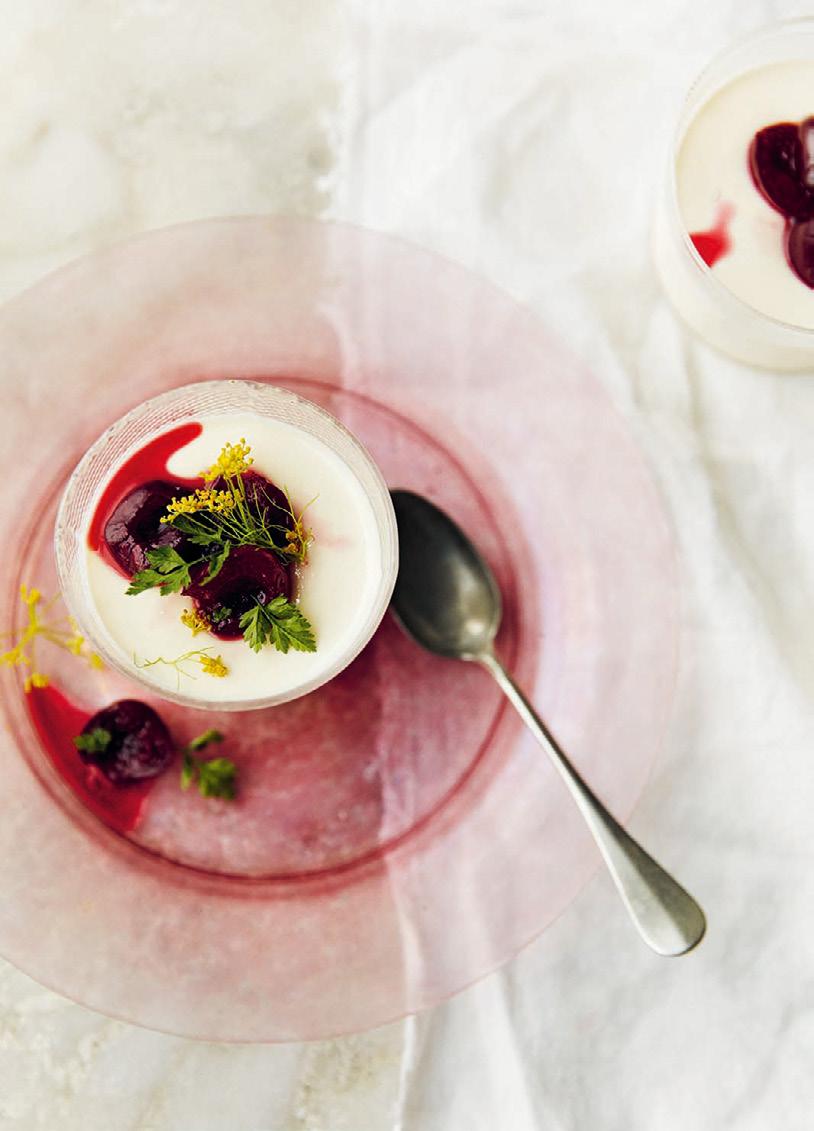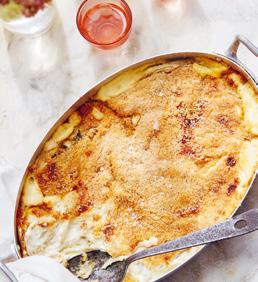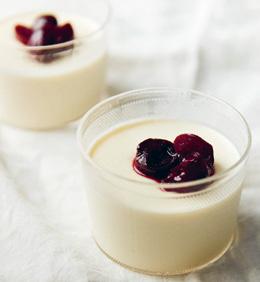
8 minute read
A SLICE OF SUNSHINE
by Dales Life
Letitia Clark invites you to try these simple and nourishing dishes from her kitchen in Sardinia
Advertisement
FENNEL GRATIN Gratins are instant crowd-pleasers

PEAR, PECORINO AND RICOTTA RAVIOLI These are surprisingly delicate and dainty ravioli

ALMOND PANNA COTTA WITH ROSÉ POACHED CHERRIES AND WILD FENNEL A wonderfully gentle, creamy way to finish a meal

It is hard not to fall for these rustic, chubby, Sardinian cousins of ravioli. More like dumplings, they are made of a simple semolina pasta dough stuffed with a filling of cheese, garlic, potato and mint, and shaped into an oval parcel with a plaited seam formed by a series of deft nips and tucks. The Sardinians say they resemble an ear of wheat. Like ravioli, culurgionis are poached in salted boiling water for a few minutes and served with tomato sauce and grated pecorino, or occasionally sage butter.
SERVES 6–8

FOR THE FILLING 700g yellow potatoes 3 tablespoons olive oil 1 egg 1 small garlic clove, grated 100g pecorino, finely grated, plus extra to serve 80g Parmesan, finely grated, plus extra to serve 70g Provoletta, other mild soft cow’s cheese or cheddar, finely grated handful of mint leaves, finely chopped sea salt, to taste
FOR THE DOUGH 300g semolina 1 tablespoon olive oil pinch of sea salt
TO SERVE 1 x quantity tomato sauce of your choice basil leaves
METHOD
First, make the filling. Drop the potatoes into a saucepan of well salted water and bring to the boil. When the potatoes are cooked through, drain well and peel them with your fingers (much easier when they are warm) and pass them through a ricer or mouli. Mix with the oil, egg, garlic, cheese and mint. Mix together well (I find this easiest with my hands) and taste for seasoning.
Add salt if necessary. Cover and place in the fridge for at least 30 minutes, or long enough to cool, but you can also make it the night before and leave overnight, if you like.
Next, make the dough. Mix all of the ingredients with 140ml water using your hands or a stand mixer and knead until you have a smooth, even dough; this will take at least 5 minutes of good, firm kneading. Wrap in cling film and leave to rest for half an hour. Again, you can do this the night before.
Roll out the dough with a pasta machine or a rolling pin, adding flour when necessary, until it is 1–2 mm or so thick. Use a highball glass to cut circles from the dough. Take a walnut-sized piece of the filling, shape it smoothly and place it in the centre of the dough. Using your left hand to cup it, fold and pleat the dough over itself to encase the filling. Place on a tray and set aside.
Once made, these will keep for about 4 days in the fridge and freeze well. When ready to cook, bring a large pan of salted water to the boil. Drop in the culurgionis and cook for 2–3 minutes until they rise to the surface. Remove with a slotted spoon and place into a warm sauce. Stir to coat and serve with basil leaves and cheese.
There are few things that aren’t better when baked in a creamy sauce and cooked under the grill until crisp on top. Gratins are instant crowd-pleasers, and so simple to put together. The two main ways to make a gratin are with a traditional béchamel, or with a simple cream reduction, the latter of which is used in this recipe. I love béchamel, but the delicacy of fennel seems to work better this way. A staple vegetable in Sardinia, fennel provides a clean and fresh flavour throughout the year. This is a wonderful way of using them, and is delicious served with steak, fish or roast pork, or even just on its own.
SERVES 4 AS A MAIN OR 6 AS A SIDE

butter, for greasing 3 fennel bulbs, sliced to ½cm thickness 350ml double cream 1 garlic clove, bashed sea salt pinch of grated nutmeg 50g Parmesan, grated 30g breadcrumbs
METHOD
Preheat the oven to 190°C/fan 170°C/gas 5. Generously butter a medium-sized gratin dish.
Bring a pan of salted water to the boil. Drop in the fennel slices and cook for two minutes, until just translucent, but not floppy. Drain well, pat dry with paper and lay them in a buttered gratin dish.
Heat the cream with the garlic clove in a small saucepan and bring almost to the boil – at which point, take off the heat and set aside to infuse for 10 minutes. After this time, fish out the garlic and season the cream with salt and nutmeg, tasting as you go.
Add a third of the cheese and stir until incorporated. Pour the cream over the fennel.
Sprinkle the breadcrumbs and the rest of the Parmesan over the top and bake in the oven for around 25 minutes, until golden and bubbling.
PEAR, PECORINO AND RICOTTA RAVIOLI
Based on a brilliant recipe by Emiko Davies, these are surprisingly delicate and dainty ravioli that will win over any sweet-with-savoury sceptic. The filling can be made well in advance and kept in the fridge for a few days. The ravioli are very good served simply with olive oil, fresh basil in summer and a little extra cheese. The filling can be made well in advance and kept in the fridge for a few days.
SERVES 6

3 pears, peeled, cored and halved 1 tablespoon brown sugar peeled zest of ½ a lemon 350g ricotta 100g pecorino, grated, plus extra to serve sea salt 1 x quantity fresh egg pasta dough semolina, for dusting sage butter a handful walnuts, toasted
METHOD
In a small saucepan, poach the pears gently in a little water with the sugar and lemon until they are just soft, about 10 minutes. Allow to cool, then slice them into tiny pieces, about the size of a petit pois.
In a small bowl, mix the pear with the ricotta, pecorino and a good pinch of sea salt, then taste for seasoning. The mix needs to be well seasoned, because ricotta drinks salt.
Cut the pasta into 4 pieces and roll each into a long thick strip using a pasta machine, or a rolling pin, until it is thin enough to just see your hand through. Keep dusting your surfaces with semolina to prevent sticking. Dust a tray with semolina ready to place your ravioli onto.
Using a piping bag or a teaspoon, dot walnut-sized amounts of your filling 5cm apart, in the centre of your wide strip of pasta. Cut each into a strip containing just 3 of your ravioli. Lightly brush the lower half with a little water and fold over the top half of the pasta sheet to enclose the filling. Press down gently using the palms of your hands and seal the ravioli all the way around. Cut them out into squares or half-moons, depending on your preference. Place on the tray and chill for 30 minutes.
When ready to cook, bring a large pan of well-salted water to the boil, and have the sage butter ready to go in a frying pan big enough to accommodate all the ravioli. Drop in your ravioli and cook them for 3–4 minutes, until they bob to the surface and the pasta is cooked through.
Decant them with a slotted spoon into the sage butter, stir gently to coat and serve, with toasted walnuts and more grated pecorino on top.
Panna cotta is a wonderfully gentle, creamy way to finish a meal. It couldn’t be easier to make. There are some lovely rosé wines made in Sardinia, and whilst I rarely drink them, I like cooking with them. The wild fennel highlights the delicate anise flavours of the cherry and wine, but if you cannot find it then chervil is a good substitute.
SERVES 6

200g whole peeled almonds 550ml single cream 3 strips of lemon zest 80g caster sugar 2 gelatine leaves
TO SERVE 300g cherries 1 glass of rosé wine 100g caster sugar zest and juice of ½ lemon fronds of wild fennel or chervil
METHOD
Set the oven to 170°C/fan 150°C/gas 3½. Roast the almonds until they just begin to smell nutty, for about 8–10 minutes. Once they’ve cooled a little, roughly chop. In a small saucepan, bring the chopped almonds, cream, lemon zest and sugar to the boil then simmer very gently, stirring occasionally and allowing the almonds to seep their flavours into the mix. After a few minutes, remove from the heat and set aside.
In the meantime, soak the gelatine in a bowl of cold water. When it is totally soft, add it to the warm mixture and stir well. The gelatine should dissolve completely (if it doesn’t, warm the whole mix a little again). Strain through a fine sieve into a pouring jug. You can keep the almonds to add to your porridge or muesli the next day.
Divide your mixture into ramekins or serving dishes of your choice. Chill in the fridge until set, around 3–4 hours. If eating the next day, cover well and remove from the fridge an hour or so before you want to eat them.
Stone and halve the cherries. Place them in a shallow pan with the wine, a splash of water, sugar and lemon zest. Cover. Bring to a simmer and then poach until the cherries are soft but not mushy, around 10–15 minutes. Taste the sauce and reduce to your taste, adding more lemon juice or sugar to your liking. Allow to cool. When ready to serve, spoon the cherries on top of the panna cottas and scatter with the fennel or chervil.
Recipes are taken from Bitter Honey by Letitia Clark, with photography by Matt Russell, published by Hardie Grant, £26.









